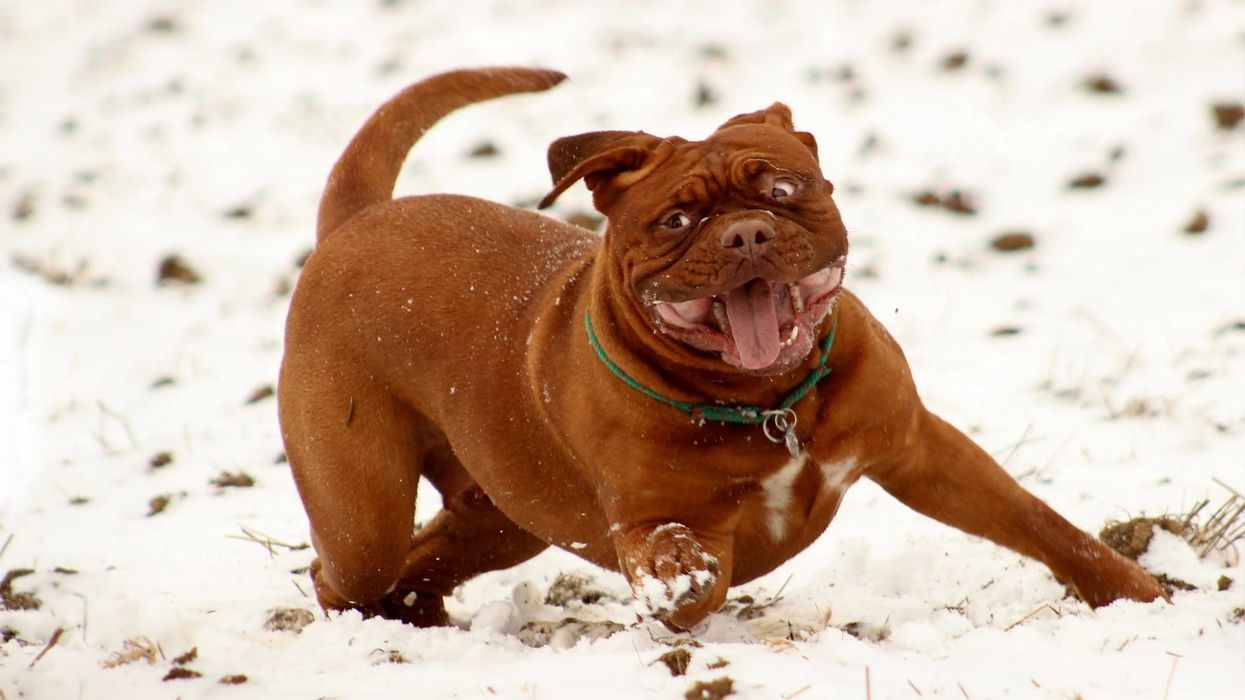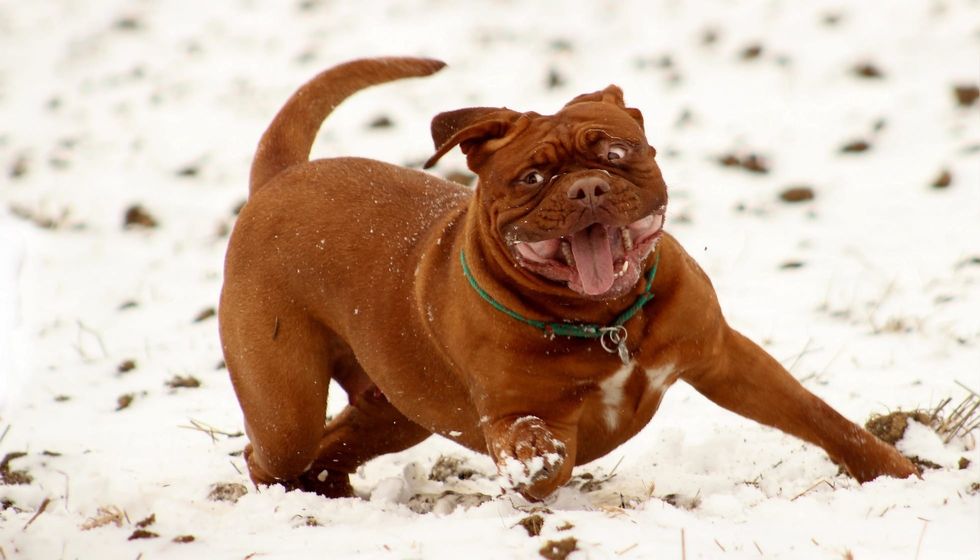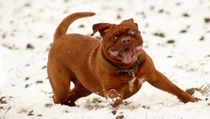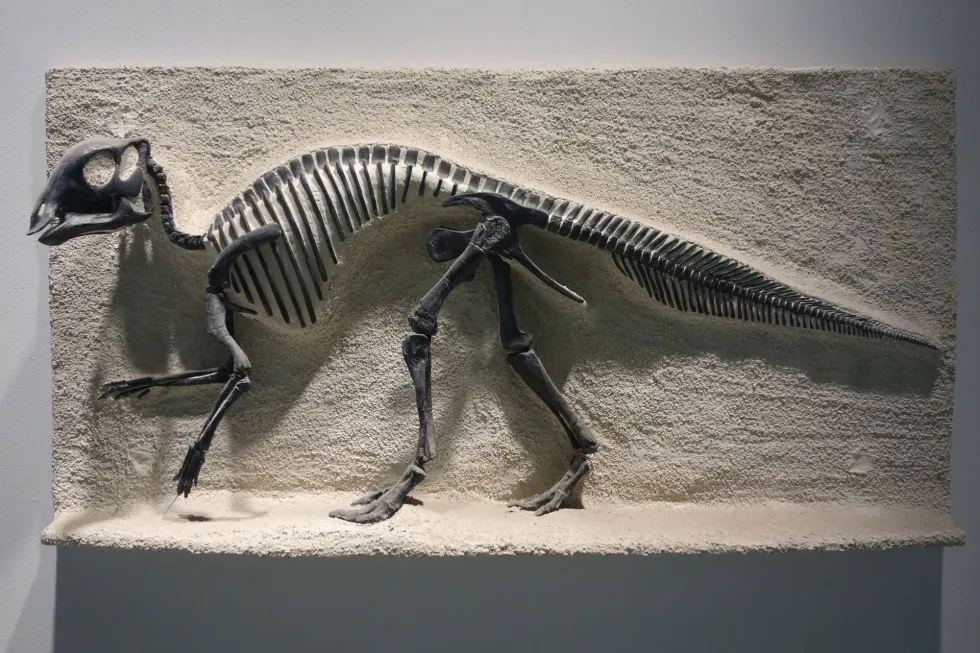Fun Mastiff Facts For Kids

Content
- What type of animal is a mastiff?
- What class of animal does a mastiff belong to?
- How many mastiffs are there in the world?
- Where does a mastiff live?
- What is a mastiff's habitat?
- Who do mastiffs live with?
- How long does a mastiff live?
- How do they reproduce?
- What is their conservation status?
- What do mastiffs look like?
- How cute are they?
- How do they communicate?
- How big is a mastiff?
- How fast can a mastiff run?
- How much does a mastiff weigh?
- What are the male and female names of the species?
- What would you call a baby mastiff?
- What do they eat?
- Are they slobbery?
- Would they make a good pet?
- Did you know...
- Characteristics and health issues
- Getting your own mastiff
Mastiffs are a dog breed belonging to the category of large-sized dogs. They are huge, and their appearance makes them look aggressive, but they actually have a very calm demeanor.
Mastiffs have a double coat which needs to be brushed regularly. Shedding is constant and their bodies get overheated quickly, so mastiffs cannot survive in very hot weather.
The diet of a purebred mastiff should only consist of meat, but as all dogs are omnivores, mastiffs can be fed plant material as suggested by a veterinarian.
This breed has been recognized by the American Kennel Club, Australian National Kennel Club, Canadian Kennel Club, New Zealand Kennel Club, Continental Kennel Club, and the United Kennel Club. As per the Dog Registry of America, there are different kinds of mastiffs, such as American mastiff, English mastiff, neapolitan mastiff, Tibetan mastiff, Italian mastiff, and bull mastiff.
These dogs love to engage in a variety of dog sports as it allows them to manage their energy levels efficiently. These massive dogs were initially used in gladiator sports, bull baiting and bear baiting in Italy.
Mastiff’s temperament, as suggested by the Mastiff Club of America under the American Kennel Club, is courageous, dignified and good-natured.
They are one of the breeds that are great family dogs, despite their history of being fighting dogs. They are family dogs that will guard their owners and will only be aggressive if they suspect any danger.
If you enjoyed reading these mastiff facts, please read our other articles to learn about other dogs such as pocket pitbull and lab chow mix.
Mastiff Interesting Facts
What type of animal is a mastiff?
Mastiffs are large-sized, guardian dogs known for their calm and cool behavior, similar to an American Staffordshire. The American Kennel Club recognized mastiffs as a breed in the year 1885.
Dogs of mastiff breed are massive family-oriented dogs who will protect and guard the house. They are one of the oldest dog breeds ever known. American mastiffs are a crossbreed of the Anatolian and the English mastiff, while bull mastiffs are generated by crossing a bulldog and mastiffs.
Brazilian mastiffs are a hybrid of a bloodhound and mastiffs. Like the bull mastiff, French mastiffs have a large head. Tibetan mastiffs originate from Tibet and have a thick fur coat that is golden, brown, or gray in color.
They were used by shepherds as hunting dogs to protect the shepherds against wild predators. All mastiffs have the tendency to snore loudly and salivate excessively.
What class of animal does a mastiff belong to?
English mastiff dog breeds belong to the category of mammals. Their huge size can make them look ferocious and wild, but English mastiff dogs are owned as companion and guardian dogs.
They have a friendly personality and are very social. English mastiff dogs are gentle around children and can be kept as family dogs. They have the natural instinct to be protective of their owners and will be aggressive around those who try to harm them or their loved ones.
English mastiff dogs love cuddling and receiving affection from the owner. Mastiff puppies need a lot of attention and care, while adult English mastiffs need dog sports and daily exercise.
How many mastiffs are there in the world?
There are several types of mastiffs such as the Tibetan mastiff, bullmastiff, French mastiff, neapolitan mastiff, English mastiff, and American mastiff. The conservation status of the mastiff dog breed is Not Listed on the IUCN Red List.
But this dog breed is quite popular in England as well as the United States. English mastiff dogs are popular because of their calm demeanor and massive personality. They are usually crossbred with other breeds, which naturally keeps their population at a steady growth.
Where does a mastiff live?
English mastiff dogs can live in a house with their owners where the temperature is moderate. They should not be left outside when the temperature is too hot as their double coat makes it difficult for them to survive in hot weather.
English mastiff dogs require a lot of attention from their owners and they love being a lapdog. They are kind and loving towards children and elderly.
English mastiff puppies can suffer from loneliness or anxiety if they are left alone for a long period of time.
Loss of human contact can also affect their temperament, making them restless and anxious. English mastiff dogs require grooming and regular training to ensure that they are not affected by any serious health conditions.
What is a mastiff's habitat?
English mastiff dogs can adapt to an apartment with adequate living space. They are not athletic and do not need an open space like a garden or field but they do require regular exercise to maintain their weight.
Mastiffs are generally huge in size and excess weight gain may trigger health conditions that can decrease their life span. Mastiffs have a lifespan of eight to ten years which is very short when compared to smaller dogs.
They also love to be couch potatoes due to their lazy nature, and sometimes sleep on their humans lap.
English mastiff dogs require an ample amount of attention and constant human touch. Tibetan mastiffs love to live in high altitudes where the oxygen level is low, while English and American mastiffs need a cool climate to survive.
Who do mastiffs live with?
Mastiffs live with their owners, and the personality of this dog breed develops according to their owner. Mastiffs can be companion or guardian dogs, but they should not be tied to a fence outside and must be welcomed inside the house as English mastiff dogs are attention-lovers.
They become overprotective of their owners and can be aggressive when they sense danger around them. English mastiff dogs emit low growls and tend to snore loudly.
Dogs of this breed are very low-maintenance and only require weekly grooming and brushing, but regular training is very important.
They have short hair but shed excessively. Mastiff puppies are stubborn and need obedience training from their initial stages of development to grow into highly-trained, obedient dogs.
How long does a mastiff live?
Mastiffs are known to have an average lifespan of eight to ten years. English mastiff dogs can also live a shorter lifespan if they endure health conditions like hip dysplasia, weight gain, or bacterial and viral infections.
They are heavy-muscled, and a diet that is high in protein and low in fat is ideal for mastiffs. The meals should be given in equal proportions, and their diet must be controlled.
A well-balanced diet along with exercise will help English mastiff dogs to thrive. They are social and love being around human beings, but they are slow learners and do not have high intelligence levels.
How do they reproduce?
All dogs reproduce through copulation. Female mastiffs, after completing a gestation period of 63 days, will give birth to a litter of between six and eight puppies.
The signs of pregnancy in mastiffs are difficult to tell because of their huge body, but changes like increase in appetite, swelling, darkening around the nipples, and morning sickness are some signs which will tell you that your female mastiff is pregnant.
Mastiff puppies are very stubborn in nature and need a lot of training. English mastiff dogs can cause havoc in the house if left alone and because of their large size they can even destroy furniture.
They also need care and attention from their owners.
Dog lovers who are keen on getting an English mastiff puppy as a pet should only buy the puppy from a registered breeder to ensure that the dog has been raised in a suitable environment. The owners must receive all the required information about the puppy and health conditions that the parent breeds have suffered.
What is their conservation status?
The conservation status of mastiffs is Not Listed on the IUCN Red List. Mastiff type dog breeds are fairly popular in Europe and the United States and are known for their qualities of being exceptional guard dogs.
Their population is also increasing due to breeding practices. Owners should be wary of unethical breeders who do not consider the health of the mastiff before breeding them with other dogs.
They are far from Extinct and are known as one of the largest dog breeds in the world, due to their body weight. They were also used for bull battling and bear battling activities which were later considered unlawful.
Mastiff Fun Facts
What do mastiffs look like?
Mastiffs are giant dogs, who have a body mass of 120-230 lb (54-104 kg). Their standing height is an average of 27-36 in (68-91 cm), giving them a bulky look. Although their appearance might look violent, they are very loving and compassionate.
In fact, many people dearly refer to them as gentle giants. Dogs of this breed have large heads and are covered in a double coat. Their fur may be apricot, fawn, or brindle in color and it is usually short in length.
Their eyes are pitch black and quite small in comparison to the size of mastiffs. They have a short, dark muzzle and a distinctive black mask on their cute face and ears.
Their shoulders are sloped and muscular. They have wrinkles on their head and body like many other breeds. Their legs are very powerful and muscled.
The tail of a mastiff is comparatively short and less hairy than other breeds. The bones of a mastiff are strong which increases their bone mass. Their overall body is muscular and heavy in weight.
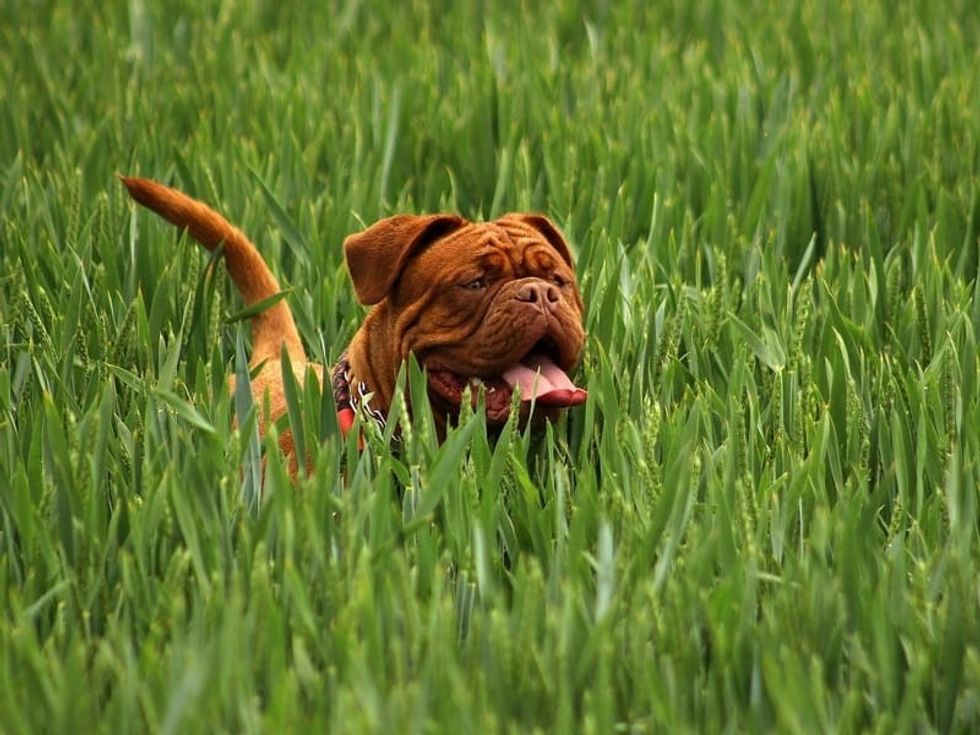
How cute are they?
Mastiffs are very cute dogs and love to sit in their owners lap. Although they are large dogs, they like to think of themselves as lap dogs.
Their barks are infrequent, and mastiffs only tend to bark when they are suspicious. Despite their gigantic personality, mastiffs require attention, pets and constant human touch from their owners.
They are slobbery, but are considered to be gentle giants as they portray loving and calm behavior around babies, adults, and elders. They are a breed that needs training during their early stages of development, or they may become a couch potato.
Lack of socialization may cause mastiffs to show unpleasant temperament around their owners and they would live a sedentary lifestyle. Mastiff puppies are extremely cute and adorable.
If trained correctly, they would be on their best behavior around human beings and would develop to be very responsive and affectionate. Mastiff puppies are difficult to train, and their low intelligence levels means it can take them a while to learn different calls and commands, so it is important to be patient.
How do they communicate?
Canines use vocalizations such as howls, growls, whines, whimpers and barks. All of these methods of communication are also used by mastiffs.
Even though mastiffs are massive dogs, they love seeking attention from their owner. These dogs like to roll on their backs and expose their belly, requesting belly rubs from their owners.
Growling may be a sign of stubbornness or dislike towards an activity such as bathing or grooming. Whimpers and whines can suggest that the dog is in pain or suffering from a health condition. Constant and continuous whimpering in dogs can be alarming, and assistance from a veterinarian should be sought immediately.
Mastiffs may also try to touch their owner when seeking attention, or they also like to rub their head on the body of their owner. Dogs try to communicate with their owners in different ways and methods.
How big is a mastiff?
According to the American Kennel Club, mastiff dog breeds are one of the largest dog breeds in the world, and they are especially known for their heavy body mass.
Although all mastiff species are heavy in weight, their sizes and weight may slightly differ. Male neapolitan mastiff dogs are 26-31 in (66-78 cm) in size and can reach an average body weight of 120-175 lb (54-79 kg).
Female neapolitan mastiffs are 24-29 in (60-73 cm) in size and can weigh anywhere between 150-200 lb (68-90 kg).
Male English mastiffs are around 200 lb (90 kg) in weight and 30 in (76 cm) tall, while female English mastiffs are 150 lb (68 kg) in weight and 27 in (68 cm) tall.
Male Tibetan mastiffs have a bodyweight of 99-160 lb (44-72 kg) while females can weigh anywhere between 75-120 lb (34-54 kg). The height of a male Tibetan mastiff is taller and can reach 26 in (66 cm), while females are shorter and have an average height of 24 in (60 cm).
The average length of a bullmastiff is 24-27 in (60-68 cm), and female bullmastiffs weigh 99-120 lb (44-54 kg), while males weigh 110-132 lb (49-59 kg).
How fast can a mastiff run?
Mastiffs have a low activity level due to their huge size. They cannot run at a very fast pace due to their heavy, muscular body but they can easily walk or jog.
If a mastiff is made to run, their body can overheat, which may cause further health problems. Mastiffs are not playful dogs, and they may get tired after an hour of exercise or walking.
They require daily exercise, but this should not include running. According to the American Kennel Club, excessive exercise may cause health conditions like joint dislocation.
They are gentle, relaxed, calm and like to be couch potatoes who prefer cuddling with their owners rather than playing in the garden. If novice owners are looking for a dog with a high potential for playfulness, mastiffs are not recommended.
Even though mastiffs are not great runners, they are good very swimmers. Mastiffs can be trained to swim, while other mastiff dogs are natural swimmers and love cooling themselves in cold water.
How much does a mastiff weigh?
The weight of a mastiff depends on the type of mastiff as the weight, length, and height of a mastiff is relative to their breed. The minimum weight of a mastiff can range from 130-220 lb (58-99 kg).
The average weight of a male English mastiff is 150-200 lb (68-90 kg) and female English mastiffs can weigh around 120-200 lb (54-90 kg). The average weight of a bullmastiff is 100-130 lb (45-58 kg).
Male and female American mastiffs can be 140-200 lb (63-90 kg) in weight. American mastiffs are popular for their loyal and gentle characteristics.
Tibetan mastiffs originated in China and have a body mass of 140-170 lb (63-77 kg) when they reach their final stage of development. Unlike other mastiffs, Tibetan mastiffs are very intelligent and can be easily trained.
What are the male and female names of the species?
Mastiffs are commonly called Old English mastiffs, and the name mastiff is used to refer to English mastiffs. Even though they are named as mastiffs they do not have the personality of a mastiff.
Mastiffs usually have a double coat which is short in length, but mastiffs who have long hair are known as fluffies. Male mastiffs do not have a common name, but all female dogs are called bitches.
This dog breed is registered with all the national kennel clubs, but their conservation status is still Not Listed despite their huge population in China, United States, and Europe. Both male and female mastiffs portray the same temperament and are gentle giants who are loving and affectionate towards their families.
Their heavy weight restricts them from running at high speeds. They naturally have an inactive personality but love indulging in cuddling and receiving pets from their owners.
What would you call a baby mastiff?
All baby dogs are called puppies. Baby mastiffs are difficult to train because of their stubborn nature. They are good-natured dogs and are known for their dignified personalities.
Baby mastiffs should be given proper attention and care. Their diet should be well-balanced and consist mostly of meat fed in equal proportions.
Baby mastiffs are adorable and grow at a very fast pace. They are playful when they are young but as they grow they stop running around the house as their muscle mass and body weight increases. Baby mastiffs should be allowed to socialize with humans and other animals from a young age.
What do they eat?
Mastiffs are giant dogs that grow at a rapid speed during their developmental stage. It is seen that the growth of a mastiff is regular when they are fed with a fully meat-based diet.
High protein diets must be consumed by mastiff puppies. The diet of an adult mastiff needs to be regulated but well-balanced.
Due to their heavy body mass, it is difficult to tell whether mastiffs are putting on weight. There is a high possibility that mastiffs may become overweight which can lead to health conditions such as diabetes and joint dislocation.
They must be fed with four to six cups of dry food daily as their total food intake is quite high.
The meals should be divided accordingly, as advised by the veterinarian. Meals should consist mostly of meat and mastiffs can consume all kinds of meat without any discomfort.
Are they slobbery?
Mastiffs are very slobbery, but they only slobber when they are anxious, hungry, or thirsty. They also drool quite a lot when compared to other dog breeds.
They snore loudly and are considered gassy dogs which may annoy some potential owners. They are very patient and good-natured, but owners who do not like dog hair everywhere should rethink their decision of keeping a mastiff as their pet.
These dogs shed excessively and there is no time of year where this shedding decreases. They growl and bark infrequently but are needy and require a lot of attention. If owners do not want dogs that slobber, drool, or shed massively, mastiffs are not a great choice.
These dogs are inactive, and mostly spend their time napping or cuddling with their owners. Their behavior can be molded into a desired manner through regular training and grooming.
Would they make a good pet?
Mastiffs are gentle, good-natured, affectionate, calm, and family-oriented, which makes them excellent pets. They are not high maintenance dogs, but money must be spent on their food as they thrive when fed with a fully meat-based diet.
They also have a massive intake of food and require eight to ten cups of dry food daily. Due to their double coat and heavy muscular body, they overheat in hot weather and may develop health conditions due to this.
Exercise should be limited, and hard-core activities like running or hiking are not recommended for mastiffs, as it may cause overheating of their body. These massive dogs require walks or jogs for 60 minutes a day.
Brushing daily is recommended and a rubber glove must be used to remove loose hair from mastiffs coats. These gentle giant dogs must be bathed once a week during the summer to cool their body down.
Mastiffs love swimming and some are natural swimmers, while others may have to be trained. Mastiffs are slobbery, gassy and drool a lot.
They are loud snorers but are the best cuddle buddies. Some mastiffs also consider themselves as lap dogs and tend to sit in the lap of their owners.
Did you know...
Mastiffs are considered to be descendants of the ancient Roman war dogs, mollosers. Their muscular physique made them popular fighting dogs and they would often be used to bring down bears and bulls.
Despite this background, they are not considered to be very healthy dogs. Mastiffs are emotional dogs and can be easily hurt by harsh words and rough treatment by their owners.
Mastiffs can also suffer from depression and anxiety if they are left alone for long stretches of time. They can be excellent watchdogs and are also used as therapy dogs.
Mastiffs are used in search and rescue missions. During the first and second world wars mastiffs almost became Extinct due to food shortages as they require a high food intake to survive.
Julius Caesar originally introduced a pack of mastiffs to Rome. Here these dogs were put on display as arena gladiators. They were then assigned to be in fights with human gladiators, bear baiting, lion baiting, bull baiting, and dog to dog combat.
Characteristics and health issues
Mastiffs are affectionate, good-natured, gentle, courageous, loyal, and affectionate dogs. They are very calm dogs, and their personality goes against their huge size. They can sometimes be stubborn and they require a lot of attention from their owners.
They are very protective of their owners and are compassionate around them. They are fun-loving and love cuddling. They end up lying around the house, napping and snoring.
They also have a high tendency to drool and shed. These dogs are also termed to be gassy. Owners who want a tidy house should not get mastiffs as there is a high possibility that they will leave dog hair everywhere.
These dogs frequently suffer from health issues like joint dislocation and hip dysplasia. They might also become overweight if fed excessively, and if their diet is not regulated. Overall, mastiffs are great family pets and will naturally protect the family from intruders.
Getting your own mastiff
Novice owners should be aware of the legitimacy of the breeders and must be introduced to the parent breeds. Trained mastiff puppies should be owned by novice dog owners as mastiff puppies are difficult to train and are very stubborn.
Mastiff puppies can cost between 1,000 USD to 1,500 USD. These prices may differ according to the authenticity and popularity of the breeder as well as the quality of the puppy.
Mastiff puppies require attention and cannot be left alone for long intervals of time. The adoption costs of a mastiff puppy start from 300 USD.
Even though mastiffs are an expensive dog breed, they still end up in adoption centers or dog kennels. It is advised that dog lovers check local adoption centers to see if they have their desired breed before looking to buy a puppy from a breeder.
Here at Kidadl, we have carefully created lots of interesting family-friendly animal facts for everyone to discover! Learn more about some other mammals including pitbull chihuahua mix, or cheagle.
You can even occupy yourself at home by drawing one of our Mastiff coloring pages.
We Want Your Photos!
More for You
See All
Bachelor of Arts and Law specializing in Political Science and Intellectual Property Rights

Anusuya MukherjeeBachelor of Arts and Law specializing in Political Science and Intellectual Property Rights
With a wealth of international experience spanning Europe, Africa, North America, and the Middle East, Anusuya brings a unique perspective to her work as a Content Assistant and Content Updating Coordinator. She holds a law degree from India and has practiced law in India and Kuwait. Anusuya is a fan of rap music and enjoys a good cup of coffee in her free time. Currently, she is working on her novel, "Mr. Ivory Merchant".
Bachelor of Science specializing in Systems Engineering

Oluwapelumi IwayemiBachelor of Science specializing in Systems Engineering
Iwayemi is a creative content writer and editor studying for a Bachelor of Science specializing in Systems Engineering from the University of Lagos. He is skilled in research and has experience writing and editing content for different organizations.
Disclaimer
1) Kidadl is independent and to make our service free to you the reader we are supported by advertising. We hope you love our recommendations for products and services! What we suggest is selected independently by the Kidadl team. If you purchase using the Buy Now button we may earn a small commission. This does not influence our choices. Prices are correct and items are available at the time the article was published but we cannot guarantee that on the time of reading. Please note that Kidadl is a participant in the Amazon Services LLC Associates Program, an affiliate advertising program designed to provide a means for sites to earn advertising fees by advertising and linking to Amazon. We also link to other websites, but are not responsible for their content.
2) At Kidadl, we strive to recommend the very best activities and events. We will always aim to give you accurate information at the date of publication - however, information does change, so it’s important you do your own research, double-check and make the decision that is right for your family. We recognise that not all activities and ideas are appropriate for all children and families or in all circumstances. Our recommended activities are based on age but these are a guide. We recommend that these ideas are used as inspiration, that ideas are undertaken with appropriate adult supervision, and that each adult uses their own discretion and knowledge of their children to consider the safety and suitability. Kidadl cannot accept liability for the execution of these ideas, and parental supervision is advised at all times, as safety is paramount. Anyone using the information provided by Kidadl does so at their own risk and we can not accept liability if things go wrong.
3) Because we are an educational resource, we have quotes and facts about a range of historical and modern figures. We do not endorse the actions of or rhetoric of all the people included in these collections, but we think they are important for growing minds to learn about under the guidance of parents or guardians.
